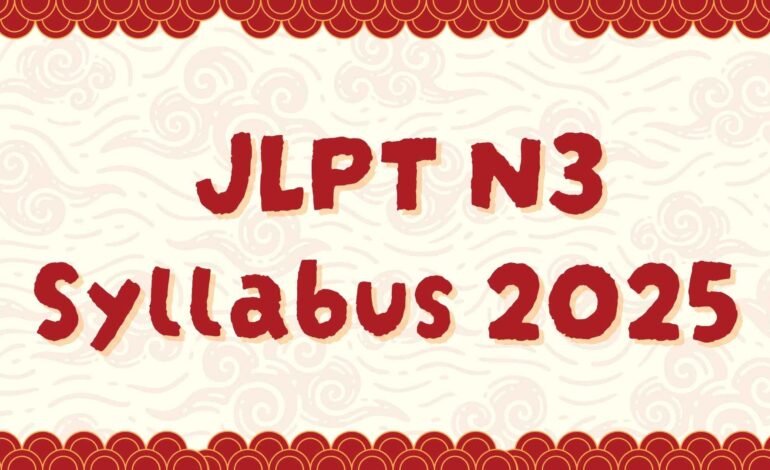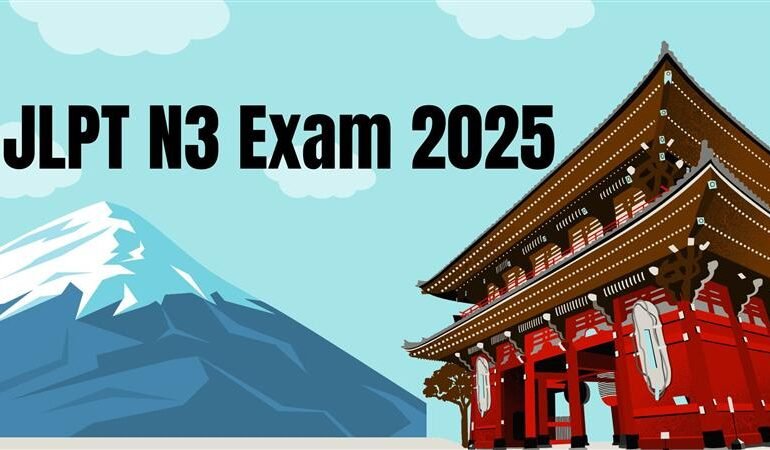
Complete JLPT N3 Syllabus 2025 Guide: Essential Grammar, Vocabulary, and Kanji
The JLPT N3 Syllabus 2025 is an essential roadmap for anyone aiming to reach an intermediate level of Japanese proficiency. Whether you are a student, working professional, or planning a career in Japan, mastering the JLPT N3 grammar list 2025, JLPT N3 vocabulary list 2025, and JLPT N3 kanji list 2025 is crucial for success. At TLS – The Japanese Language School, we guide students across India with a strategic approach, emphasizing grammar accuracy, listening skills, and vocabulary retention. Our interactive classes and real-life practice sessions ensure comprehensive preparation for the JLPT N3 Syllabus 2025 exam. Japanese Language Proficiency Test (JLPT). Official Result Link: JLPT
Why JLPT N3 Matters in 2025
The Japanese Language Proficiency Test (JLPT) is the world’s most recognized exam for measuring Japanese ability. It has five levels — N5 (beginner) to N1 (advanced). JLPT N3 stands right in the middle and represents the intermediate stage, where learners move from textbook-based learning to understanding native-level Japanese in daily life.

In 2025, Japan continues to open up job opportunities for skilled workers, IT professionals, and students under programs like the Specified Skilled Worker (SSW) Visa. For most of these opportunities, JLPT N3 is the minimum required qualification. Hence, mastering the JLPT N3 syllabus 2025 is not just about passing an exam — it’s a gateway to living, studying, or working in Japan. How to Fill JLPT OMR Answer Sheet
JLPT N3 Level Meaning: Understanding the Intermediate Stage
The JLPT N3 level represents intermediate Japanese proficiency, demonstrating the ability to understand everyday conversations, read and comprehend slightly complex texts like newspaper headlines and emails, and use around 700 kanji and 4,000 vocabulary words. It bridges basic fluency (N4) and advanced understanding (N2), essential for practical communication in Japan. JLPT Vocabulary Book
- Read and understand passages written in everyday vocabulary and kanji.
- Grasp main points from conversations spoken at near-natural speed.
- Communicate effectively in routine situations and simple professional contexts.
If JLPT N4 builds your foundation, JLPT N3 expands it with complex sentence structures, idioms, and nuanced expressions used by native speakers.
Many learners describe the N3 as the turning point — where you move beyond “survival Japanese” and begin to sound fluent.
JLPT N3 Exam Pattern 2025
Understanding the JLPT N3 exam pattern 2025 is crucial before starting preparation. The test consists of three main sections: Language Knowledge (Vocabulary & Grammar), Reading Comprehension, and Listening Comprehension. Each section evaluates your ability to understand written and spoken Japanese used in everyday life, ensuring balanced language proficiency. JLPT Exam Result
| Section | Content | Time (Minutes) | Score Range |
| Language Knowledge (Vocabulary + Grammar) | Word meanings, usage, grammar patterns | 30 | 0–60 |
| Reading | Short & medium passages, inference, and understanding context | 70 | 0–60 |
| Listening | Daily conversations, announcements, discussions | 40 | 0–60 |
| Total | 140 | 180 |
- Passing Marks: Minimum 95 out of 180
- Sectional Requirement: At least 19 points in each section
The N3 paper tests real-world Japanese comprehension rather than translation. It evaluates how well you understand meaning, context, and tone — especially in reading and listening.
JLPT N3 Grammar List 2025 (文法リスト)
Grammar forms the foundation of the JLPT N3 syllabus 2025, helping learners communicate naturally and accurately. At this level, you’ll master patterns to express opinions, emotions, assumptions, reasons, and consequences, which are essential for achieving intermediate Japanese fluency and understanding complex sentence structures in real-life situations.
Below is an organized list of major N3 grammar points categorized by their usage.
A. Expressing Purpose and Reason
In JLPT N3, expressing purpose and reason involves using grammar patterns like 「ために」 and 「ので」 to explain intentions, causes, or motivations behind actions naturally.
- ~ために (tame ni) – in order to / for the purpose of
- ~ように (yō ni) – so that / for the purpose of
- ~おかげで / ~せいで – thanks to / because of
- ~によって – due to / by means of
Example:
健康のために、毎日運動しています。
(I exercise every day for my health.)
B. Expressing Probability and Guessing
In JLPT N3, expressing probability and guessing uses patterns like 「でしょう」 and 「らしい」 to indicate assumptions, likelihoods, or impressions based on observed information or context. JLPT N1 Grammer
- ~ようだ / ~みたいだ – seems like / looks like
- ~らしい – apparently / it seems
- ~そうだ – I heard that / looks like
Example:
雨が降りそうだ。傘を持って行こう。
(It looks like it might rain. Let’s take an umbrella.)
C. Expressing Emotions and Opinions
In JLPT N3, expressing emotions and opinions involves grammar forms like 「と思う」 and 「~てしまう」 to convey personal feelings, regrets, satisfaction, or viewpoints naturally in everyday and conversational Japanese. JLPT N2 Grammar
- ~と思う – I think
- ~かもしれない – maybe / perhaps
- ~に違いない – must be / definitely
- ~られる (potential form) – can / able to
Example:
彼は日本に長く住んでいたから、日本語が話せるに違いない。
(He must be able to speak Japanese since he lived there long.)
D. Conditions and Concessions
In JLPT N3, conditions and concessions use patterns like 「~ば」, 「~たら」, and 「~ても」 to describe hypothetical situations, contrasting results, or unexpected outcomes in complex sentence structures. JLPT N3 Grammer
- ~ば / ~たら / ~なら / ~と – if / when
- ~ても – even if
- ~のに – despite / although
Example:
雨が降っても、試合は中止しません。
(Even if it rains, the match won’t be canceled.)
E. Time Expressions
In JLPT N3, time expressions play a key role in describing sequences and durations. Patterns like 「~うちに」, 「~ところ」, and 「~間に」 help express actions happening simultaneously, before, or after another event in natural conversation. JLPT N4 Grammar
- ~ところ – about to do / in the middle of / just finished
- ~ばかり – just did something
- ~うちに – while / before it changes
Example:
テレビを見ているうちに、眠くなった。
(While watching TV, I got sleepy.)
F. Giving and Receiving Actions
In JLPT N3, giving and receiving actions are expressed using verbs like 「あげる」, 「もらう」, and 「くれる」. These patterns show direction, respect, and relationships in social contexts, enhancing polite and natural communication.
- ~てあげる / ~てもらう / ~てくれる – giving or receiving favors
Example:
友達に宿題を手伝ってもらった。
(My friend helped me with homework.)
G. Causative and Passive Forms
In JLPT N3, causative and passive forms like 「~せる」 and 「~られる」 are essential for expressing actions done by others, obligations, permissions, or experiences where someone is affected by another’s actions or decisions. JLPT N5 Grammer
- Passive: 読まれる (to be read)
- Causative: 読ませる (to make someone read)
- Causative-passive: 読まされる (to be made to read)
Learning these grammar patterns with examples will help you easily handle the grammar section and reading comprehension in the JLPT N3 exam.
JLPT N3 Vocabulary List 2025 (語彙リスト)
The JLPT N3 vocabulary list 2025 consists of around 3,700 to 4,000 essential words that bridge beginner and intermediate proficiency. These words span diverse topics like daily life, workplace communication, social interactions, and education, helping learners understand news articles, conversations, and general texts used in practical, real-world Japanese situations. Kanji
Common Themes and Examples
Common themes in JLPT N3 vocabulary include daily routines, transportation, emotions, and workplace terms, with examples like 「会議」 (meeting) and 「約束」 Kanji N5
| Category | Examples |
| Daily Life | 家事 (housework), 掃除 (cleaning), 食事 (meal), 約束 (promise) |
| Emotions | 喜ぶ (to be happy), 悲しむ (to be sad), 心配 (worry) |
| Nature | 雨 (rain), 山 (mountain), 川 (river), 花 (flower) |
| Work & School | 会議 (meeting), 会社員 (office worker), 授業 (class) |
| Technology | スマホ (smartphone), メール (email), パソコン (computer) |
Pro Tip: Learn vocabulary in contextual sentences, not isolation. For instance:
昨日、新しいスマホを買いました。
(Yesterday, I bought a new smartphone.)
You can use flashcards, Anki decks, or apps like JLPT Tango N3 for daily revision.
JLPT N3 Kanji List 2025 (漢字リスト)
For the JLPT N3 syllabus 2025, learners must recognize about 650–700 kanji characters commonly used in everyday Japanese. These kanji frequently appear in both reading comprehension and vocabulary sections, testing your ability to understand newspapers, emails, advertisements, and short passages written in natural, intermediate-level Japanese. Kanji N4
Kanji by Theme
| Theme | Examples |
| Daily Life | 食 (eat), 飲 (drink), 行 (go), 来 (come) |
| Time | 昨 (yesterday), 今 (now), 明 (tomorrow) |
| Feelings | 楽 (fun), 悲 (sad), 怒 (angry) |
| Nature | 山 (mountain), 雨 (rain), 花 (flower), 空 (sky) |
| Work/Study | 試 (exam), 業 (work), 経 (manage), 学 (study) |
Tip: Create a personal kanji journal where you write the meaning, readings (on’yomi & kun’yomi), and an example word.
JLPT N3 Listening Practice Tips
The listening section of the JLPT N3 can be particularly challenging for Indian learners due to accent and speed differences. To master it, practice daily with JLPT N3 listening exercises, anime dialogues, and podcasts to improve comprehension, tone recognition, and real-life conversational understanding. Kanji N3
- Listen daily to natural Japanese – Use NHK Easy News or JapanesePod101.
- Focus on intonation and sentence endings (like ね, よ, かな).
- Take JLPT N3 mock tests online 2025 to practice time management.
- Avoid translating in your head — understand meaning directly.
- Repeat and shadow – Imitate native pronunciation for fluency.
TLS offers JLPT N3 listening drills and live mock sessions to help you build real exam speed and comprehension.
JLPT N3 Reading Comprehension Strategies
This JLPT N3 reading section tests your ability to identify the meaning, tone, and purpose of both short and long passages. It measures how well you understand context, main ideas, and implied messages in written Japanese. Kanji N2
Tips:
- Start with short passages before moving to long essays.
- Focus on key connectors (しかし, つまり, けれども).
- Skim for topic sentences first, then read details.
- Build reading stamina with graded readers and manga.
Practice daily with JLPT N3 reading comprehension PDFs and Sou Matome Dokkai N3.
JLPT N3 Mock Test Online 2025
Mock tests are invaluable during the final phase of JLPT N3 preparation. Use both official JLPT practice books and online mock tests to simulate real exam conditions, evaluate your progress, and strengthen time management and comprehension skills effectively. Kanji N1
Recommended sites:
- JLPT.jp Official Mock Test Series
- Japanesetest4you.com
- Nihongo-Pro Free Practice Tests
Analyze your weak areas — grammar, vocabulary, or listening — and revise accordingly.
How to Study for JLPT N3 in India
If preparing for JLPT N3 in India, adopt a structured approach: enroll in a reputable course, follow a daily study schedule, practice reading and listening regularly, use mock tests, and revise grammar, vocabulary, and kanji consistently for optimal results. Exam Registration
- Enroll in a structured course like at TLS – The Japanese Language School.
- Follow a 6-month study plan (2 hours per day).
- Join conversation clubs or online meetups to practice speaking.
- Use bilingual resources for understanding complex grammar.
- Stay consistent — small, daily progress matters most.
JLPT N3 Preparation Timeline 2025
A practical JLPT N3 preparation timeline 2025 spans six months: focus on grammar and vocabulary initially, then kanji and reading comprehension, followed by listening practice, mock tests, and final revisions to ensure well-rounded intermediate-level proficiency. Exam Dates
| Phase | Duration | Focus Area |
| Month 1–2 | Grammar basics + 1000 vocab + listening habits | |
| Month 3–4 | Kanji mastery + mock tests + reading speed | |
| Month 5–6 | Revision + timed tests + weak area improvement |
Stick to your timeline and assess progress weekly.
Job Opportunities After JLPT N3
Clearing JLPT N3 unlocks diverse job opportunities in India and Japan, including roles like translator, interpreter, Japanese language associate, BPO/KPO professional, or study-abroad positions. It enhances career prospects in IT, business, and education sectors requiring intermediate Japanese proficiency. Exam Result
- Japanese language interpreter
- Translator for IT or automobile companies
- BPO/KPO roles for Japanese clients
- Japanese teacher assistant
- Study abroad and part-time jobs in Japan
Cities like Delhi NCR, Bengaluru, Chennai, and Pune have growing demand for JLPT N3-certified professionals.
Recommended Books for JLPT N3
For JLPT N3 preparation, essential books include TRY! JLPT N3 for grammar and practice, JLPT N3 Vocabulary for 3,700–4,000 words, JLPT N3 Reading and Reading Comprehension N3 for passages, plus rapid guides like Complete Master in 28 Days.
- Shin Kanzen Master N3 (Grammar, Vocabulary, Reading)
- Try! JLPT N3 Textbook & Workbook
- Nihongo Sou Matome N3 Series
- An Integrated Approach to Intermediate Japanese
TLS also provides a curated JLPT N3 study kit including mock tests, vocabulary lists, and kanji flashcards.
Passing Marks and Scoring System
The JLPT N3 passing marks require a total score of 95 out of 180, with minimum section scores for Language Knowledge, Reading, and Listening. Each section is scored individually, and achieving these ensures successful certification at the intermediate Japanese level.
- Total Marks: 180
- Passing Score: 95+
- Sectional Pass: 19 points per section
Scoring Weightage:
- Vocabulary & Grammar: 1/3
- Reading: 1/3
- Listening: 1/3
JLPT N3 Certificate and Validity
The JLPT N3 certificate does not expire. It serves as a permanent proof of your Japanese ability. Employers in Japan and multinational companies in India recognize it for translation, teaching, and cross-border roles.
Join TLS for JLPT N3 Success
Want to clear JLPT N3 in your first attempt?
Join TLS – The Japanese Language School, one of India’s most trusted institutions for JLPT training.
Visit Us: TLS – The Japanese Language School
Call: +91 8700956038
Email: tls@teamlanguages.com
Our expert faculty, personalized study plans, and live mock sessions make JLPT success achievable.
FAQs
Q1. How many grammar points do I need to know for JLPT N3?
The JLPT N3 syllabus 2025 includes approximately 200–230 grammar points. These cover expressing opinions, reasons, conditions, probabilities, and emotions, which are essential for intermediate-level Japanese. Studying them systematically helps build sentence formation skills for both reading and writing sections.
Q2. How many vocabulary words should I aim for?
You should aim to learn around 3,700–4,000 words. Vocabulary spans daily life, work, society, and education. Using flashcards, apps, and context-based learning can make memorization easier and more practical.
Q3. How many kanji are required for N3?
For JLPT N3, learners must recognize about 650–700 kanji. These kanji appear in vocabulary, reading passages, and sometimes in listening. Consistent practice using kanji books, writing drills, and flashcards is recommended.
Q4. What is the JLPT N3 exam date for 2025?
JLPT is conducted twice a year, typically on the first Sunday of July and December. Registration opens a few months before the exam, so plan ahead to secure your slot.
Q5. Can I take JLPT N3 without passing N4?
Yes. There are no restrictions on skipping levels, so you can directly attempt N3 if you feel prepared. However, having N4 knowledge helps, as N3 builds on the basic grammar and vocabulary from lower levels.
Q6. How do I prepare for JLPT N3 listening?
Listening is often challenging for Indian students due to speed and accent differences. Daily practice using Japanese podcasts, NHK Easy News, anime, and shadowing exercises improves comprehension, intonation, and fluency.
Q7. What are the passing marks for JLPT N3?
The total score is 180, and you must achieve 95 or more to pass. Each section—Language Knowledge (Vocabulary & Grammar), Reading, and Listening—also has its own minimum passing score.
Q8. Does the JLPT certificate ever expire?
No, the JLPT certificate is valid for life. Once cleared, it can be used for job applications, university admissions, or visa purposes in Japan without time limits.
Q9. Which books are best for JLPT N3 preparation?
Recommended books include Shin Kanzen Master N3, TRY! JLPT N3, JLPT N3 Vocabulary, Reading Comprehension N3 Point & Practice, and Complete Master in 28 Days. Combine grammar, vocabulary, kanji, and reading-focused books for comprehensive preparation.
Q10. What jobs can I get with JLPT N3?
N3 opens opportunities as a translator, interpreter, Japanese language associate, BPO/KPO professional, or teaching assistant. Many IT and business companies in India and Japan prefer N3-certified candidates for intermediate roles.
Q11. How long should I study to clear JLPT N3?
A typical preparation time is 6–9 months for consistent learners. Intensive study plans can reduce this to 3–4 months, but it requires daily practice and mock test simulations.
Q12. How is the JLPT N3 scored?
Each section—Language Knowledge, Reading, and Listening—has a separate score, all totaling 180 points. Section-wise minimum scores are required, ensuring balanced language proficiency.
Q13. Can I clear JLPT N3 in 3 months?
Yes, but only with a structured, intensive study plan. Focus on grammar, kanji, vocabulary, reading, and listening daily. Regular mock tests and revision are crucial for success.
Q14. Are mock tests necessary?
Absolutely. Mock tests help familiarize you with the exam format, manage time, identify weak areas, and build confidence. Use both official practice books and online tests.
Q15. How many sections are there in JLPT N3?
The exam has three sections: Language Knowledge (Vocabulary & Grammar), Reading Comprehension, and Listening Comprehension. Each section tests practical Japanese skills in context.
Q16. Are online courses effective for N3 preparation?
Yes. Structured online courses provide lessons, exercises, and mock tests. They are especially helpful in India, where classroom access may be limited, allowing flexibility and guided learning.
Q17. How should I study kanji for N3?
Use flashcards, writing drills, kanji books, and context-based reading. Focus on recognizing characters, reading compounds, and remembering common words. Daily practice is key to mastery.
Q18. What does JLPT N3 level mean?
N3 represents intermediate Japanese proficiency. Learners can understand everyday conversations, moderately complex texts, and written instructions, bridging basic fluency (N4) and advanced understanding (N2).
Q19. How can I improve reading comprehension?
Practice short and long passages, underline key points, summarize paragraphs, and use N3 reading materials. Focus on main ideas, tone, context, and implied meanings.
Q20. Is N3 enough for jobs in Japan?
Yes, for entry-level or intermediate roles. For advanced positions, N2 or N1 is preferred. N3 is sufficient for work in BPOs, language support roles, or basic office jobs.
Q21. How do I manage time during the exam?
Allocate time per section, practice with mock tests under timed conditions, and avoid spending too long on individual questions. Prioritize understanding and accuracy.
Q22. Can mobile apps help in preparation?
Yes. Apps for vocabulary, kanji, grammar, and listening drills are highly effective. They enable practice on-the-go and help reinforce memorization through spaced repetition.
Q23. How many kanji appear in reading passages?
Around 600–700 kanji are tested in reading and vocabulary sections. Familiarity with their readings and meanings is essential for comprehension.
Q24. Should I study grammar or vocabulary first?
Both should be studied simultaneously, but starting with grammar builds a foundation for sentence construction while vocabulary enhances comprehension and expression in reading and listening.
Q25. Can I retake JLPT N3 if I fail?
Yes, there’s no limit on attempts. Candidates can register for the next exam session and continue preparation using past papers, mock tests, and improved study strategies.
Conclusion
The JLPT N3 syllabus 2025 is your bridge from beginner to fluent Japanese. By mastering grammar, vocabulary, and kanji, and consistently practicing listening and reading, you’ll develop a genuine command of the language.
If you’re serious about passing JLPT N3 and exploring Japan’s cultural and professional opportunities, now is the perfect time to start. With expert guidance from TLS – The Japanese Language School, success is not just possible — it’s guaranteed with effort and consistency.Call now: +91 8700956038
Email: tls@teamlanguages.com





